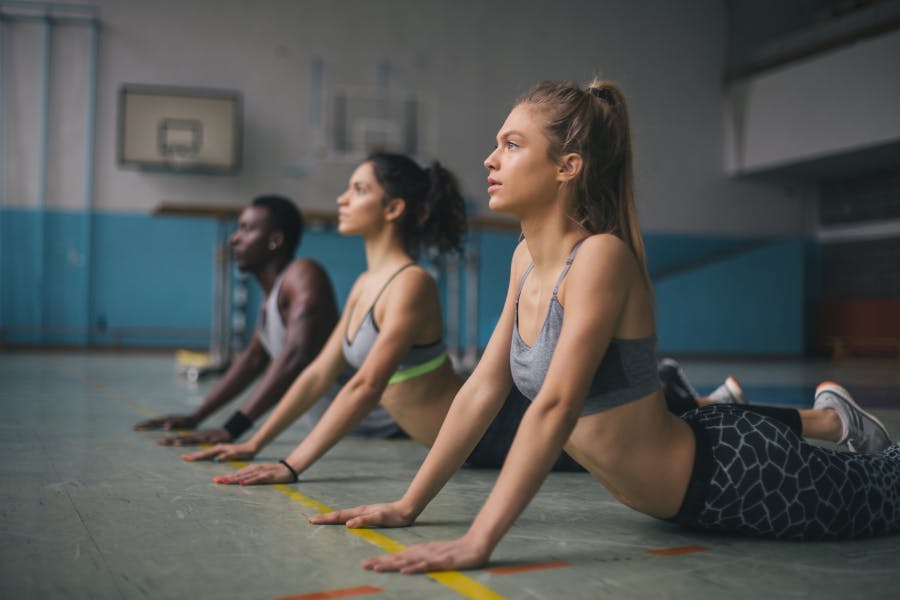Yoga for Back Pain
Backache
Yoga for Back Pain
Whether you’ve been perfecting your Downward-Facing Dog for years or you just looked up your first “Beginners Yoga” tutorial on YouTube, developing a yoga practice can be beneficial to your health, both mentally and physically. Research has shown that the health benefits of yoga may include improving overall fitness level, improving posture and flexibility, reducing stress, improving self-confidence, lowering blood pressure and heart rate, aiding with digestion, and helping improve sleep quality, among other things.1 Yoga can also help with back pain, and because it requires little to no equipment, yoga is one way you can start helping manage your back pain symptoms today!
What Is Yoga?
Yoga is an ancient practice that originated in Indian philosophy, but in more recent years has been embraced in the United States as a practice that focuses on physical postures, breathing techniques, and meditation.2 There are many different types of yoga styles, each with a slightly different focus and level of intensity. Some popular styles that you may already be familiar with are ashtanga, also known as power yoga, bikram, or hot yoga, hatha yoga and kundalini.1 When approaching yoga for back pain, it’s important to consult an expert to find the right style to meet your needs.
How Can Practicing Yoga Benefit Your Health?
Yoga can benefit your health in many different ways. Perhaps the most well-known reason why yoga may be good good for you is because it can help you relax by relieving stress, which can help improve your mental health and sleep.2 Yoga is also thought to help with menopause symptoms, anxiety and even symptoms of chronic illnesses.2
Yoga and Pain Management
Studies also show that yoga can help relieve physical symptoms of pain as well.2 While there is some evidence that yoga can be helpful for headaches and knee osteoarthritis pain, the effects of yoga on lower back pain and neck pain have promising results.2 In fact, yoga is a recommended option for treating chronic lower back pain.2
What Causes Back Pain?
Back pain is a common condition that can happen to anyone.3 Some factors that can cause back pain include excess body weight, lifting heavy objects with your back instead of your legs, lack of exercise, age and smoking.3 Both physical and mental conditions can also contribute to back pain. Disease such as cancer and arthritis can contribute to back pain, and psychological conditions such as anxiety and depression can put you at risk.3
How Does Yoga Help Relieve Back Pain?
Yoga is good for relieving back pain because it can be especially helpful for the muscles that support the back and spine.4 When practicing yoga, you use a series of postures that teach you to stretch and strengthen your muscles to help reduce muscular tension, build flexibility and improve balance and bone structure.4 Plus, yoga can also help with the mental aspects of back pain. The slow movements and focus on proper breathing can help alleviate stress and anxiety affiliated with pain.4
5 Yoga Poses for Back Pain
No matter which style you end up sticking with, there are a few yoga poses for back pain that are simple enough to try at home. Yoga is generally safe, but make sure to be gentle when you first start out. If you have an underlying health condition, talk to your doctor about whether or not specific yoga poses will be safe for you.1
1. The Forward Fold
Start from the standing position, with your arms at your sides and your feet together. Bend over, moving your head towards the floor and let your upper body hang parallel to your thighs. If this is too difficult, you can bend your knees to help get the full stretch. Slowly breathe in and out, and try to straighten your knees.
2. Child’s Pose
Start kneeling on your yoga mat or on the ground, with your knees as wide as your hips folded beneath you and your feet touching behind you. Gently move your forehead towards the ground, so that your torso is laying on top of your thighs. Extend your arms in front of you and lengthen your neck.
3. Low Lunge
Begin standing with your arms at your sides and feet together. Bend at the hips and begin lowering your torso to the ground. Place your hands on the ground on both sides of your feet. Bend your right knee and take a big step backwards with your left foot. Straighten your left leg. Your toes should be curled and planted on the mat. Uncurl your toes, lower your left knee to the ground and lower your hips slightly. Keep your tailbone tucked. Release and repeat on the other side of your body, bending your left knee and extending your right leg.
4. Cat/Cow
Get onto all fours, with your shoulders aligned over your wrists and your hips lined up with your knees. To go into “Cat,” exhale, drop your head towards the ground, and round your spine. On the inhale, transition into “Cow,” by arching your back and lifting your head, tailbone, and chest upwards. Slowly alternate between these two positions in sync with your breath.
5. Seated Spinal Twist
Sit on your yoga mat or the ground with your legs crossed in a comfortable position. Lift your left knee and move your left foot so that it’s planted on the ground outside of your right thigh. Reach both hands towards the ceiling, and twist your torso towards the left, making sure to keep your hips firmly planted on the ground. Place your right elbow outside your left knee and place your left hand on the ground behind you. Inhale and lengthen your spine. Exhale and gently twist your spine, starting with the lower back, then middle back, and finally upper back. Hold the position and then repeat on the other side, with your right foot outside your left thigh, left elbow outside your right knee, and right hand on the ground behind you.
Although more research on yoga and its effect on pain are still being done, studies suggest that yoga can help with chronic back pain, and is even sometimes recommended as a first-line, non-drug treatment for low back pain.2 When you’re ready to try it yourself, make sure to wear comfortable clothing that will let you move without restriction, drink plenty of water before and after, and remember to take a gentle approach by resting if you feel fatigue or pain.1
Looking for more information on topics like exercise and pain management? Explore Tips & Resources from Advil.
Source Citations:
- Yoga for health. MedlinePlus. https://medlineplus.gov/ency/patientinstructions/000876.htm Accessed 07/23/20.
- Yoga: What You Need to Know. National Center for Complementary and Integrative Health. https://www.nccih.nih.gov/health/yoga-what-you-need-to-know Accessed 10/17/22.
- Back pain. Mayo Clinic. https://www.mayoclinic.org/diseases-conditions/back-pain/symptoms-causes/syc-20369906 Accessed 10/17/22.
- The safe way to do yoga for back pain. Harvard Health Publishing. https://www.health.harvard.edu/staying-healthy/the-safe-way-to-do-yoga-for-back-pain Accessed 10/17/22.
By clicking the link(s) above, you will be taken to an external website that is independently operated and not managed by Haleon. Haleon assumes no responsibility for the content on the website. If you do not wish to leave this website, do not click on the links above.








